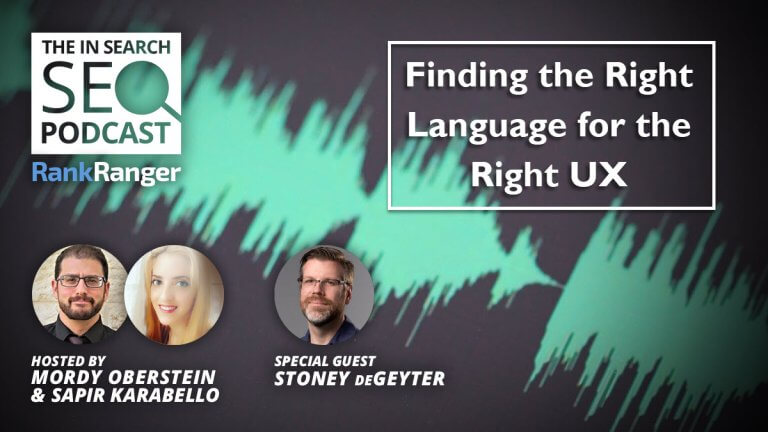 Marketing Intelligence
Marketing Intelligence
In Search Podcast: The Right Language for the Right UX

Don’t forget, you can keep up with the In Search SEO Podcast by subscribing on iTunes or by following the podcast on SoundCloud!
SUMMARY OF EPISODE 29: THE IN SEARCH SEO PODCAST
Big time guest this week as we welcome Stoney deGeyter who shares his wisdom on the right language for the right UX:
- Creating language to deal with Google’s multiple intent targeting
- The right language for the right UX for both traditional AND voice search
- The role of UX within Google’s algorithm
Plus, we break down the mobile’s SERP’s new design… Are organic result favicons really a win for sites?
Who Benefits from the Google Redesigning the Mobile SERP? [2:02 – 15:06]
If you haven’t seen the new mobile SERP let’s get you up to date. The new mobile SERP now contains favicons in the organic results, black (not green) URLs, and a colorless ad label.
Sapir thinks it’s great as it saves a lot of time since you can easily find reliable sites that you’re already familiar with without too much trouble, and even for the less known sites it could help by increasing brand recognition. All-in-all she thinks it’s a great new addition.
Mordy asked Sapir to tell him the honest truth, “When you see a favicon, either on the mobile SERP now or in the tab of the browser… does it matter to you? Does it make you remember the brand any more than you did without it?”
Sapir answered, “Of course it does. Even if it’s a brand I’m not familiar with, if I click on the link and like what I’m seeing, chances are that I’ll remember the site and the brand better, and will likely revisit the website if I encounter that same favicon again. I think it can definitely help smaller brands gain brand recognition.”
According to Mordy, favicons will only help the big brands. Why?
Mordy did a search for something related to birdhouses. What he saw in the first result had a favicon that he didn’t recognize at all. He was about to click it until he saw the Mashable and Time Magazine favicons. Upon seeing the more familiar icons he completely forgot about the first and less familiar result. Basically, once Mordy saw the icons of those who were familiar to him, he ditched the first, and possibly best, organic result.
If favicons depend on clicks to bring brand awareness, then not garnering those clicks diffuses its power.
So again, favicons on the SERP are big for big brands but could be an impediment for smaller brands.
More than that, Mordy thinks that the favicons may prove detrimental to Google themselves, from a certain perspective. We all like shiny things and this is where Mordy thinks Google is doing a disservice to itself with favicons. Say you’re a smart SEO. You get on your graphics team to come up with the shiniest, the glossiest, the most gleaming icon you could ever imagine. When the user does a search they’ll see some great results, wonderful results – all things being equal. But now, users will also see your shiny icon and they won’t be able to help themselves. There’s a good chance they’ll skip those good, relevant, solid sites and head over to your thin, skimpy piece of content because you have a shiny icon!
Obviously, we’re embellishing a bit, but you know this won’t do anyone any good. Why? If the content isn’t as good as other sites and users click on it they are going to bounce which isn’t good for the site nor is it good for Google. The point is the user should be going to the page with the most relevant content and not the shiniest icon.
But that’s not the biggest issue as what we gained in favicons we lost in name. What does that mean? The mobile’s SERPs URLs are not only black, but they’re smaller. So what you may ask? How about the fact that the name of the site sits in the URL!
And you may also ask, “Who cares? We now have the favicon!”
Mordy cares.
First off, how big is the Favicon? It’s tiny! And there’s some interesting data on icons like the Favicon. For example, a study from the Journal of Brand Management says that a logo that has both an icon and the brand name is far more impactful than just having either the brand name or icon in isolation.
So for all of you shouting, “YAY, favicons!” know that it’s not the same thing as having your full logo.
In fact, Venngage and Survey Monkey teamed up to get a look at how people feel about logos and icons and colors and whatnot. What they did was give people six different logo styles, icons without text, just text logos, logos that were outlines, logos that were filled in, etc.
They then asked the users how they felt about these icons types in relation to all sorts of sites (educational sites, finance sites, retail sites, etc.).
The style of logo that was just an icon or dominated by an icon (i.e., with text in very small font) were the LEAST trusted form of icon/logo in almost all of the niches (to the exclusion of education sites). So there’s your favicon!
Also, according to Mordy, having your site’s name in a much smaller font in favor of a favicon may not be the big win you think it is. Think about it. Let’s say you don’t know the site’s logo. How does just seeing it on the SERP help you? Whereas if I read the name I would now know the brand.
There’s another reason why I think the new design of the mobile SERP does a disservice to the brand name and that is Breadcrumbs. It used to be the brand name would appear in two places: the URL itself and in the Breadcrumbs. The way it used to work was with the bigger and greener URLs you had Breadcrumbs and the first Breadcrumb was the site’s name.
No longer! Now the first Breadcrumb is the URL. They got rid of the brand name! Sure, the name is there in the URL but it’s lost in the www. It doesn’t stand out. If you look at the old SERPs and new SERPs it’s very noticeable!
Using Language to Create an Attractive UX: A Conversation with Stoney deGeyter [16:57 – 39:58]
[This is a general summary of the interview and not a word for word transcript. You can listen to the podcast for the full interview.]
Mordy: Welcome to another In Search SEO podcast interview session. I know I say this often, but you’re in for a treat as today we have the author of The Best Damn Web Marketing Checklist, Period! He is, and I’m just quoting his Knowledge Panel, an author, speaker, teacher, husband, father, and web marketer! He is also the vice president of search and advertising at The Karcher Group. He is the one, the only, Stoney deGeyter!
Stoney: Thank you! Thanks for having me.
M: By the way, we have something in common. We both finished high school at 16, although for you it’s something to brag about for me it’s because I had enough of institutionalized education which partly explains why I became a teacher.
S: Yeah, I graduated a month before I was 17. I actually skipped eighth grade so that’s my excuse.
M: Before we get into the thick of things, would you like to tell us more about what you do at The Karcher Group?
S: So I’m the head of the Search and Advertising department which basically means my job is to build a team that focuses on SEO and PPC marketing tactics and strategies.
M: Awesome. So we’re going to head into the wild world of UX. Before we do that, could you get us started here by telling us why language is such an integral part of your site’s UX, just so that we’re all on the same page?
S: Language is how we communicate and how we talk in keywords. We usually think of keywords as what we type when we search but that’s really how we talk, reference, and relate to things. It’s simply the words we use to describe whatever we want. So language plays a huge role in that because without being able to use keywords we won’t be able to coherently get what we want. We won’t be able to give our visitors the information they’re seeking. It’s all about not just understanding the words but also the meaning behind the words.
M: There is so much emphasis on elements like Featured Snippets and so forth. In these cases, Google has its own “language” preferences when looking for content to place within its SERP features. These language preferences may stand in sharp contrast to your user’s preferred use of language. How do you balance this out?
S: Well it comes down to how the information is presented on the page so Google can pull it into the Snippets. But in actuality, if you want to optimize for these Featured Snippets, you need to put it in a format that’s good for visitors as well. The more we see of these changes Google makes you’ll see it’s less about SEO and more about giving what users want and it’s not just what the information is but how it’s given. Google for many years has been rewarding marketers for presenting content correctly and for Featured Snippets if you present the information in a way that makes sense, that’s readable, that’s digestible, Google will pull that information and display it in their search results.
You can say Google has been more in tune with the user than ever. And us SEOs who got ahead of Google, who foresaw where Google was going, are succeeding mightily. We don’t care about what the algorithm is now, we care about it for next week, next year, and so on.
M: How can you use language in order to cater to multiple user intents? That is, the use of one term or of certain phraseology may only be applicable to one type of user. How then can you consider multiple user profiles without sounding redundant?
S: If you’re focused on the user intent it’s about focusing on the content that fulfills that intent. Yes, we still look at the keywords like what are the core keywords and what are the ancillary keywords that fill out this topic. And that’s why I do keyword research. Not necessarily to get the exact phrasing being used but to understand the concepts and the meanings behind the words. And then I’ll find keywords that will really give people what they want and that’s where the related keywords come into play.
For example, if you’re talking about dog food but don’t mention the health and nutrition of your pet then you’re missing out and Google will then find articles that do mention those things as being more relevant for people searching for dog food.
M: Yeah, I recently wrote an article about this how keyword research has changed to the point that it’s about understanding content topically as opposed to just finding high volume search phrases in particular.
S: Years ago, you had one keyword and you would optimize that on the page and you had another keyword and you optimize that on the page. This was long before people started talking about topics. It’s not taking 5 phrases anymore. It’s taking 15, 20, 30, 40, or 50 phrases that are all extremely tied in relevancy. Maybe they’re different word orders or different tenses or different words with similar meanings. You can create a page that focuses on all of it without being repetitive or redundant because it’s all part of the natural language.
When doing keyword research you’re looking for all of these similarities and seeing how you can take one topic and break into smaller chunks with each of those chunks targeting a handful of very focused keywords with all of them very focused on content.
M: Yeah, you’re pretty prophetic about this. I saw you speak about this in 2017 long before everyone was on the bandwagon.
S: Yeah, and I’ve been doing it long before Hummingbird. We were just able to see the benefits of those changes.
M: So on this, at what point, from a UX perspective, would you say that a page is too topically broad and that you need to divide it into multiple pages?
S: It’s really a case by case question. I’ll give you an example. Let’s say you’re dealing with jewelry. There are hundreds of directions you can go with jewelry so you can’t write one singular authoritative page that will cover every aspect of jewelry. But somewhere in that keyword research you can see patterns like cheap, discount, and sale. So you can create a page on your site that addresses these issues like when your jewelry goes on sale. On the other hand, you’ll see keywords like vintage, classic, and antique. Those keywords will then go on another page. You’ll be foolish to put both of those groups on the same page. Then you can keep doing that and this can take hours and hours of time thinking of what keywords to put together and what keywords to separate. Then you can let that mold itself just by looking at the intent behind the words. And then you can create your topics. If you’re shoving too many things together with different intents then you know you’re covering too much.
M: Let me switch gears for a second. So language fascinates me, I used to be an English teacher, and what piques my curiosity is how to deal with different cultural uses of language. How do you deal with unique cultural uses of language when targeting multiple user demographics? (Particularly, when you’re not dealing with monolithic content, like a product page for an electronic device, for example.)
S: Sometimes you can’t. Sometimes you want to create unique pages targeting those cultures. I’m currently writing a presentation on this topic and in it I discuss how you can take content that you’ve written and rewrite it for different demographics, different industries, or different levels of jobs (management vs lower end). You can create new content for a new audience even though you’re targeting essentially the same thing yet you’re doing it in a different way by providing a new value for each separate audience.
M: Similarly, let me apply this to voice search. One of my ‘soap box’ topics is that simply targeting long tail keywords is not an effective voice search strategy. When I used to teach English, one of the most striking things was the variance in how my students spoke versus how they wrote – with the latter being far more formal and relying on all sorts of different language devices. Since oral language and written language are just two different beasts, how do you go about catering to the user’s experience on a given page while also taking voice search optimization into account (which uses a different language paradigm altogether)?
S: A lot of times people say write how you speak. And we try to be natural, but at the same time, you’re right that we speak differently than we write. Especially in business where generally people speak very fluently and slangy in business it’s not done at all. So there’s really only so far you can go with speak how you write.
On the other side of that, you have voice search which really comes down to Google’s problem. I don’t think we need to optimize specifically for voice search in terms of phrasing.
And if you’re writing four topics, i.e., if you’re writing for intent, that intent is going to capture how people search by voice versus how they search by keyword versus how they search by phone, texting or whatever. It should capture all of that because Google doesn’t care about any of those things specifically, it cares about the intent. So if you’re optimizing for intent you’re going to get that no matter what.
M: Wow, I have to say that I love you because I think you’re the only person I’ve ever heard say it’s Google’s problem, and it is. Google has to figure out a way to build that bridge that covers the gap between the different language formats.
S: Yeah, and they’re getting a lot better at it because they have to. Voice search is becoming more and more popular. It’s Google’s job to build that bridge as you just said, and make sure that it’s providing the most relevant results based on what people are saying they want.
And Google is looking clearly at the intent. It doesn’t matter the language being used nor the slang nor the word order. None of that really matters because Google’s asking for the intent and is going to deliver it to the user whether you have it word for word on the page or you have it optimized for voice. I don’t think any of that’s going to matter. Maybe it does now but I don’t think it’s going to matter in the next 2-3 years.
M: I very much agree. Okay, let me switch directions one last time and talk about Google’s holistic abilities to analyze a page. Do you think that UX is a direct signal that Google looks at? That is, not in terms of its impact on bounce rate and the like, does Google have a way to interpret the quality of a site’s UX?
S: I would say yes and no on that. I’m really torn between the two sides that either say that Google does look at this data or that Google does not. The ‘not’ camp will say Google doesn’t look at that data because they don’t have access unless they’re following Chrome and user behavior through that. Google even said that they don’t have enough of a sampling to really, truly be able to do that.
So if we take Google at their word then we can say they’re not using that data, but they are looking at how it interacts with search results. They can track if someone bounced back to the search results and they’re going to use that to determine how should this rank. Are people coming back to us because they didn’t find what they’re looking for?
They also have to analyze based on the type of page and site. For example, if a user bounces on a page very fast it could be they only needed the business’ phone number. Then they went back to the search results and got another phone number. In that case, they got what they needed from the site.
I think Google has to look at the different industries, the different pages, and the different types of content and weigh all that accordingly as it’s never one size fits all. That’s the one thing we have to understand about the algorithm. What works for one site, one industry, or even one page is not necessarily what’s going to work for anything else.
M: Yeah, I think it’s more the page level than the niche level. Let’s take an e-commerce page for example. Do you think Google has the ability to understand what sort of language or UX is good for an e-commerce page versus what’s not good? Intrinsically, almost like a set of standards.
S: Yeah, I think so. They do have the tools that will tell you if your site is mobile-friendly or not. So yes, in that sense they are looking at a lot of those usability issues.
They may not be actual user metrics, but those usability issues are things that they have told the algorithm and are based on user metrics that they have probably been able to analyze on other websites that have Google Analytics installed. So it may not be a direct do this versus that, but they do work these into the algorithm based on what they know.
Optimize It or Disavow It
M: If you could do just one; would you focus on UX from a language perspective or from a design perspective?
S: So the options are user experience versus user interface?
M: Basically, yes. Either creating languages the way you want the user to walk away with which then pulls them in and makes them feel at home versus creating a design that does the same thing.
S: I would go with content because that’s what persuades people. Yes, the UI is going to affect whether they stay on your site or find the information they’re looking for but I think people will move past that that for great content.
M: You’re a man after my own heart. Always content first. All right, Stoney, thank you very much for coming on. I do really appreciate you taking the time. This is great and very insightful.
S: It was fun. Thanks for having me!
SEO NEWS [40:20 – 46:03]
New Sites to be Mobile-First Indexed: Google says that all new sites that make their way to the web will be indexed by the mobile-first index right from the start.
Google AdSense Bug Preventing Ads from Displaying: Yet another Google bug. This time to AdSense as a bug seems to have been preventing a large number of ads from displaying.
Google Ads Expanding Targeted Locations Area: Google Ads is now letting you target users who may not be in your target area but do searches related to your target area. Mordy loves this as he knows he will be a great candidate as someone who does a lot of New York searches but doesn’t live there.
Popular Dishes in Google Maps!: Google Maps is now showing a carousel of a restaurant’s most popular dishes. The feature will be rolling out soon for iOS devices but is available now on Android. Mordy believes this will lead to an increase in reliance on the Local Panel for restaurant owners as they will want to ensure the carousel appears as more users will expect to see the menu beforehand.
Augmented Reality Images Have Arrived on the SERP: 3D images on the SERP are here! Do a search for your favorite animal on mobile and you should see the new 3D images which have AR functionality! As cool as it is Mordy believes it’s not a big deal for SEO.
Fun SEO Send-off Question [46:03 – 48:05]
What does Google’s Voicemail say?
Sapir thought it would sound like, “Hello, you’ve reached Google, we’re not able to answer your call at the moment. We’ll call you back when we feel like it. What are you going to do? Call Bing?”
Mordy’s answer was, “You’ve been searching for Google. Unfortunately, you’ve just hit a 404. Please leave your number and we’ll be sure to call you back. Have a blessed day.”
Thank you for joining us! Tune in next Tuesday for a new episode of The In Search SEO Podcast.
The #1 keyword research tool
Give it a try or talk to our marketing team — don’t worry, it’s free!






